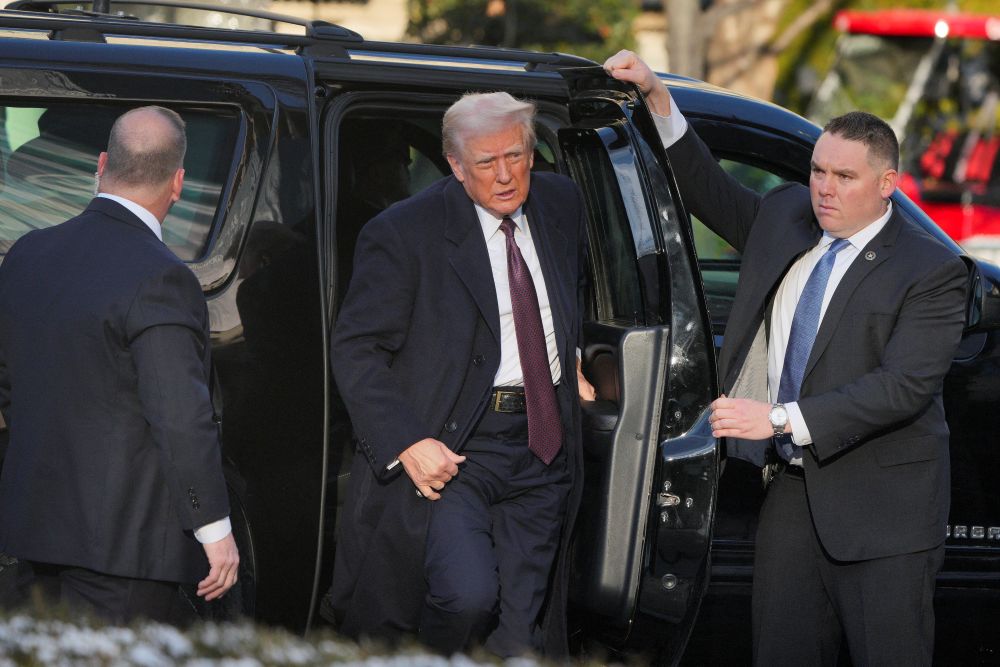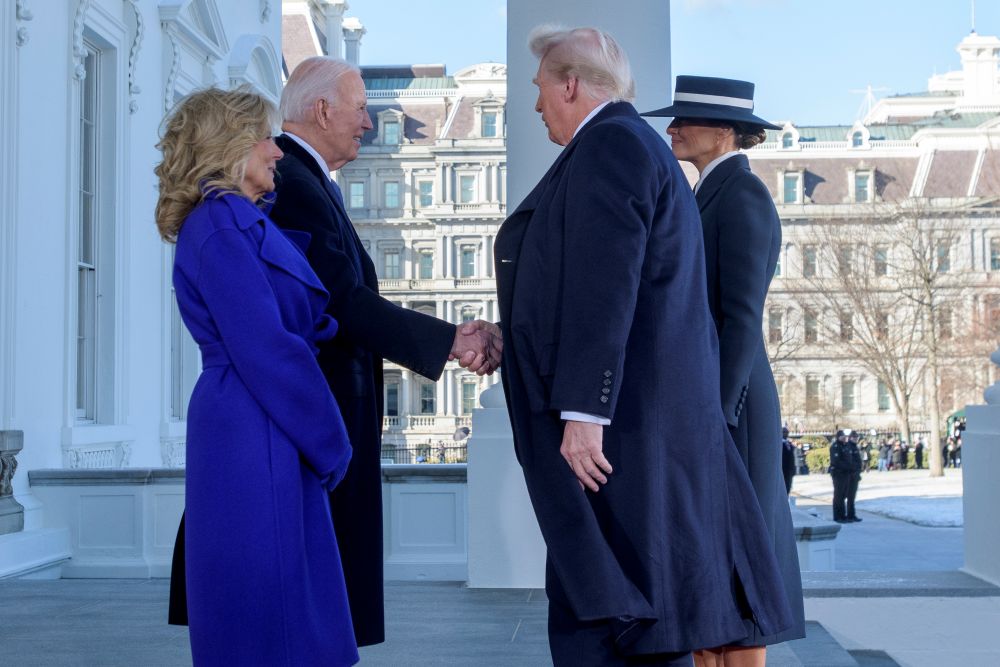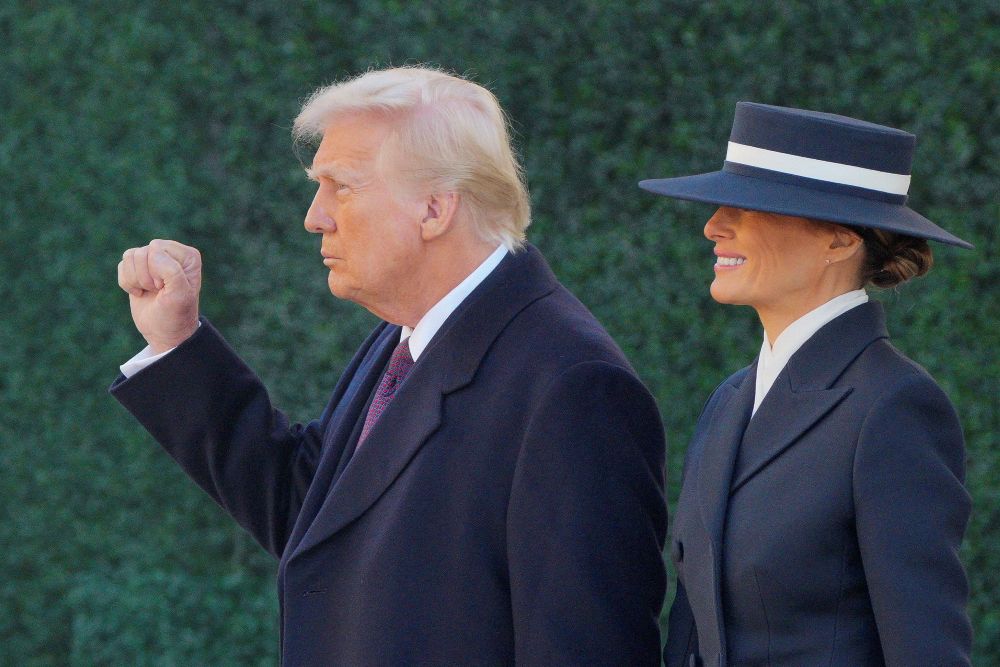LONDON: On Monday, the 47th president of the US will be sworn in at a ceremony at the US Capitol in Washington D.C., marking perhaps the greatest political comeback in American history.
For the Middle East, the second inauguration of Donald Trump is expected to usher in a new era of US engagement, overseen by an instinctively disruptive president who is as hard to read as he is transactional.
If any evidence was needed that the incoming administration is eager to wield its influence in the region, it came on January 15, when the outgoing president announced the long-awaited Israel-Hamas ceasefire-for-hostages deal had finally been agreed.
For the now former president, Joe Biden, announcing the breakthrough “after eight months of nonstop negotiation by my administration,” it should have been a triumphant, legacy-defining moment. Instead, he was blindsided by the first question hurled at him by the media.
“Who will the history books credit for this, Mr. President?” a reporter called out. “You or Trump?”

US President-elect Donald Trump arrives for a service at St. John’s Church on Inauguration Day in Washington, US, Jan. 20, 2025. (Reuters)
Biden, clearly shocked, paused before replying: “Is that a joke?”
But it wasn’t a joke. The only thing that had changed about the ceasefire deal that his administration had been pushing for since May last year was that Israeli Prime Minister Benjamin Netanyahu had finally agreed to it.
And the only thing that had changed for Netanyahu was that the man he sees as his friend and most important ally was about to return to office.
For Netanyahu, this seemed the right moment to present Trump with a gift — vindication of the new president’s boast that he would end the war as soon as he took office.
Trump even dispatched Steve Witkoff, his newly appointed envoy to the Middle East, to join Biden’s man, Brett McGurk, for the last 96 hours of talks in Doha, to ensure that the incoming US administration had its mark on the deal.
The appointment of Witkoff came as a surprise to many, as he does not have a diplomatic background. Witkoff does, however, have a reputation as a formidable dealmaker, which fits with Trump’s fondness for transactional foreign policy.
But quite what deal Witkoff might have offered Netanyahu on Trump’s behalf remains to be seen.
“The ceasefire in Gaza is something Trump has claimed credit for, which is unclear. But we shouldn’t think his arrival is good news,” said Kelly Petillo, MENA program manager for the European Council on Foreign Relations.
“We have no idea what Trump has in mind for day-after plans in Gaza. And we don’t know what Trump and his Middle East envoy have promised to Netanyahu in return for him accepting to move forward with the ceasefire.
“We don’t even know if the ceasefire will hold until the next, second phase. The ceasefire does not involve the release of all the hostages and Trump has declared he will ‘unleash hell’ if not all of them are released.”
Unlike Biden, said Ahron Bregman, a former Israeli soldier and senior teaching fellow in the Department of War Studies at King’s College London, “Trump is not someone Netanyahu can easily ignore.
“Even before Trump assumed office, he pressed Netanyahu to strike a deal with Hamas. As a result, Netanyahu surprisingly showed a willingness to concede assets — such as the Philadelphi route — which he had previously deemed critical to Israeli security.”

US President-elect Donald Trump, US Vice President-elect JD Vance and his wife Usha Vance attend a service at St. John’s Church on Inauguration Day in Washington, US, Jan. 20, 2025. (Reuters)
When the ceasefire deal was announced, Trump wasted no time taking to Truth Social to tell his 8.5 million followers: “This EPIC ceasefire agreement could have only happened as a result of our Historic Victory in November, as it signaled to the entire World that my Administration would seek Peace and negotiate deals to ensure the safety of all Americans, and our Allies.”
Itamar Rabinovich, a former Israeli ambassador to the US, anticipates a gear change in US relations with the region.
“I expect greater involvement in the Middle East by the Trump administration,” said Rabinovich, professor emeritus of Middle Eastern history at Tel Aviv University.
“In the Arab-Israeli context (there will be a) continuation of the effort to end the war in Gaza and possibly to move on to a more ambitious effort to resolve the larger Israeli-Palestinian conflict.”
However, Trump’s natural affinity with Israel, expressed most keenly through the Abraham Accords, to which he is expected to return with renewed energy, does not bode well for the Palestinian cause. Neither do some of the appointments to Trump’s top team.
His appointment of former Arkansas governor Mike Huckabee as ambassador to Israel indicates that any “resolution” of the Israeli-Palestinian conflict favored by the incoming US administration will favor Israel, at Palestine’s expense.
Huckabee, an evangelical Christian with deep, biblically inspired connections to Israel, a country he has visited more than 100 times since 1973, is an open opponent of Palestinian sovereignty.
He is an ardent supporter of settlements, stating during a 2017 visit to Israel that “there’s no such thing as a settlement — they’re communities, they’re neighborhoods, they’re cities. There’s no such thing as an occupation.” He has also said “there’s really no such thing as a Palestinian.”
Trump’s new Secretary of State, Marco Rubio, is another staunch ally of Israel who has called for a clampdown on pro-Palestinian protesters in the US and condemned “the poison” of the boycott, divestment, and sanctions movement. He has also said there should be no ceasefire in Gaza until Israel has destroyed “every element” of Hamas.
The nomination of pro-Israel Congresswoman Elise Stefanik as ambassador to the UN bodes ill for attempts to pursue Palestinian sovereignty through the UN General Assembly.
Last May, on one of many trips she has made to Israel, she addressed members of the Knesset, “in your eternal capital, the holy city of Jerusalem,” declaring herself “a lifelong admirer, supporter, and true friend of Israel and the Jewish people.”
In the wake of Trump’s scene-stealing intervention in the Gaza ceasefire deal, all eyes in the region will be on his wider agenda for the Middle East. At the top of that agenda is Iran. How that plays out could have serious repercussions for Tehran’s neighbors.
Around that, said Petillo, “there is huge unpredictability. Trump is highly unpredictable and likes to remain that way. But we also know that much of what he will do depends on who whispers in his ear at the right time before he is making a decision.
“There are different people in his administration that might push him to go either in the most destructive direction — for instance seeking other maximum pressure style policies to support Israel and address their security concerns vis-a-vis Iran — and others who want to end US involvement in the region and are in favor of deals.”

President Joe Biden and first lady Jill Biden welcome President-elect Donald Trump and Melania Trump on the North Portico of the White House in Washington, Jan. 20, 2025. (AP Photo)
But any chance that the Iran nuclear deal will be reinstated surely evaporated with Trump’s re-election. It was, after all, Trump who unilaterally withdrew America from the deal in 2018, instituting new sanctions. He has signalled his intention to return to a policy of “maximum pressure.”
“More widely on Israel-Palestine, Trump will likely pick up where he left off — the Abraham Accords, which he deems a success and which have largely held so far despite rifts caused by the war in Gaza,” said Petillo.
“The big prize of course is a Saudi deal — and I think this will impact whether he will do another round of maximum pressure on Iran as he said he would.”
Saudi Arabia has made clear that any move toward normalization of relations with Israel would be dependent on clear steps towards Palestinian sovereignty.
In September, Crown Prince Mohammed bin Salman said the Kingdom “will not stop its tireless work towards the establishment of an independent Palestinian state with East Jerusalem as its capital, and we affirm that the Kingdom will not establish diplomatic relations with Israel without that.”
Shortly after, Saudi Foreign Minister Prince Faisal bin Farhan Al-Saud announced the formation of a global alliance to push for a two-state solution to the Israeli-Palestinian conflict.
Implementing the two-state solution, he said, was “the best solution to break the cycle of conflict and suffering, and enforce a new reality in which the entire region, including Israel, enjoys security and coexistence.”
But according to Petillo: “Trump’s arrival is not good news for the chances of a two-state solution. Trump and his new administration simply don’t care about Palestinian rights, annexation is likely to be used as a threat and settlements are likely to expand, and the whole issue risks becoming a big real-estate project, with huge consequences for Palestinian security, but I think also for that of ordinary Israelis.”
In November, Bader Mousa Al-Saif, an associate fellow on the MENA program at Chatham House and a historian at Georgetown University, wrote that Trump would find the Gulf region much changed since he last engaged with it.
Since then, “the Arab Gulf states have made strides in the intervening years by taking matters into their own hands — reconciling intra-Gulf discord, freezing the Yemen conflict, and making overtures to regional neighbours like Iran, Syria, and Turkiye.”
Moreover, he added, “the Saudis have banked on a clear precondition for normalization — the end of Israeli occupation and establishment of a Palestinian state.”
However, according to Ibrahim Al-Marashi, associate professor in the Department of History at California State University San Marcos, a different kind of deal could break the deadlock.
“Trump’s repudiation of the Iran nuclear deal served as the primary causal factor in intensifying tensions, escalating into direct violence,” he said. “This violence played out primarily on Iraqi soil, albeit with a brief period of clashes in Syria.
“Trump wants a nuclear deal on his terms that he can claim credit for. If he gets that and sanctions are lifted on Iran, then tensions might finally subside.”

US President-elect Donald Trump and his wife Melania Trump after attending a service at St. John’s Church on Inauguration Day in Washington, US Jan. 20, 2025. (Reuters)
Burcu Ozcelik, a senior research fellow on Middle East security at the Royal United Services Institute, believes “the Trump administration will be unlikely to backtrack on, or jeopardize, the progress that has been made to weaken Iran’s status in the Middle East.
“The region is transforming in ways unimaginable 15 months ago, with new political futures possible in Lebanon and Syria,” he said. “The weakening of both Iran and Russia in the Middle East represents a success story, and Trump will want this dynamic to continue — and to take credit for it.”
And to be recognized for it, as a main plank of his legacy.
“Trump’s desire for a Nobel Prize might push him toward pursuing a peace deal or normalization between Israel and Saudi Arabia,” said Bregman.
“Achieving this would require Netanyahu to make some progress toward a Palestinian state, a prerequisite for advancing Israeli-Saudi relations. This won’t be easy. But Netanyahu’s wariness of Trump might compel him to act.”































